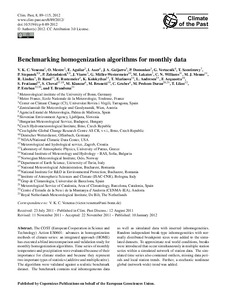Por favor, use este identificador para citar o enlazar este ítem:
http://hdl.handle.net/20.500.11765/1510
Benchmarking homogenization algorithms for monthly data
| Título : | Benchmarking homogenization algorithms for monthly data |
| Autor : | Venema, Victor K. C.; Mestre, Olivier; Aguilar, Enric; Auer, Ingeborg; Guijarro Pastor, José Antonio


|
| Palabras clave : | Surface climate network; Instrumental climate records; Temperature records; Precipitation records; Homogenization |
| Fecha de publicación : | 2012 |
| Editor: | European Geosciences Union |
| Citación : | Climate of the Past. 2012, 8(1), p. 89-115 |
| Versión del editor: | https://dx.doi.org/10.5194/cp-8-89-2012 |
| Resumen : | The COST (European Cooperation in Science and Technology) Action ES0601: advances in homogenization methods of climate series: an integrated approach (HOME) has executed a blind intercomparison and validation study for monthly homogenization algorithms. Time series of monthly temperature and precipitation were evaluated because of their importance for climate studies and because they represent two important types of statistics (additive and multiplicative). The algorithms were validated against a realistic benchmark dataset. The benchmark contains real inhomogeneous data as well as simulated data with inserted inhomogeneities. Random independent break-type inhomogeneities with normally distributed breakpoint sizes were added to the simulated datasets. To approximate real world conditions, breaks were introduced that occur simultaneously in multiple station series within a simulated network of station data. The simulated time series also contained outliers, missing data periods and local station trends. Further, a stochastic nonlinear global (network-wide) trend was added. |
| Patrocinador: | This study has been performed with support of the European Union, through the COST Action ES0601 – Advances in Homogenisation Methods of Climate Series: an Integrated Approach (HOME), as well as the project Large Scale Climate Changes and their Environmental Relevance funded by the North Rhine-Westphalia Academy of Science. The contribution of VV was supported by the surrogate cloud project (VE 366/3), the one of RL by the Daily Stew project (VE366/5), both sponsored by the German Science Foundation (DFG). The contribution of EA was sponsored by the “Cambios en la Frecuencia, Intensidad y Duracion de eventos Extremos en la Península Ibérica”, code number: CGL2007-65546-C03-02. |
| URI : | http://hdl.handle.net/20.500.11765/1510 |
| ISSN : | 1814-9324 1814-9332 |
| Colecciones: | Artículos científicos 2010-2014 |
Ficheros en este ítem:
| Fichero | Descripción | Tamaño | Formato | ||
|---|---|---|---|---|---|
| cp-8-89-2012.pdf | 551,49 kB | Adobe PDF |  Visualizar/Abrir |
Los ítems de Arcimis están protegidos por una Licencia Creative Commons, salvo que se indique lo contrario.





